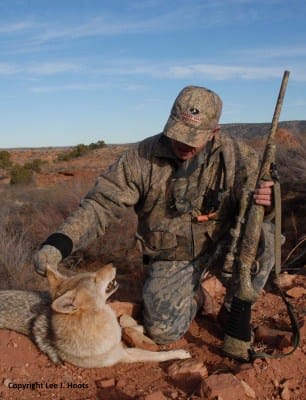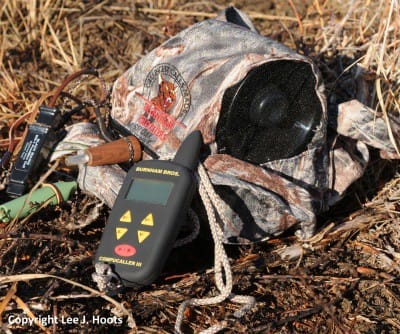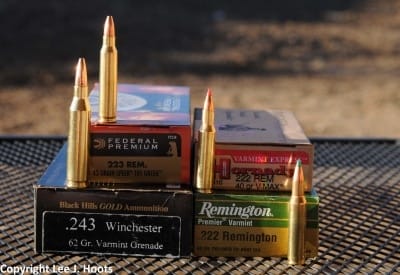 Forty-seven years ago, a young Texan began a life-long pursuit of one crafty canine, the American coyote. At the time, Gary Roberson was just a pup himself.
Forty-seven years ago, a young Texan began a life-long pursuit of one crafty canine, the American coyote. At the time, Gary Roberson was just a pup himself.
“I started calling critters when I was 10,” he says. “I’ve hunted fourteen different states and Mexico for coyotes, if memory serves me. I don’t know how many coyotes I have seen come to the call, as I never kept records.”
To Roberson, owner of Burnham Brothers game call company, coyote hunting means much more than piling up hides.
“My roots in chasing coyotes are extremely deep,” says Gary. “My Great Grandfather Erskine Outlaw hunted coyotes with hounds in the early 1900s and was one of the founders of The South Texas Wolf Hunters’ Association. They had their first meet [hunt] in 1921. This meet grew so large-more than 1,200 in attendance-that Life and Time magazines covered the event in 1936. I have a copy of Life from 1936 with my great uncle, A. E. Outlaw, in it.”
Roberson’s approach to calling is straight forward and simple, and honed by nearly fifty years of field experience. The first step to consistent success, he says, is to weed through the misinformation and misconceptions found on chat rooms and ill-authored books and magazine articles.
What follows are his top eight bits of advice when it comes to dealing with the following misconceptions:
Forget the wind, just hunt… “Even though a coyote has excellent vision and hearing, he depends more on his olfactory senses when feeding or hunting. On several occasions I have watched coyotes approaching dead prey animals such as rabbits, rodents or birds. While the coyote’s eyes tell him its food, he will not pick up the prey animal until he smells it, approaching from downwind. Set up where it is difficult for an approaching coyote to get your wind without exposing himself.”

Howling is the best calling technique…“Coyotes are territorial and there is generally an alpha male and female that may aggressively respond to howling within a given area. However, a lesser dog may want to avoid confrontation. Distress sounds appeal to a higher percentage of the population.”
You’ll call in more dogs at night… “Calling predators-especially bobcats-at night can be very effective. But I feel that I will call as many coyotes in daylight and do a much better job of putting them on the ground. I just love watching a coyote respond to a call as he is so graceful, and I cannot observe this very well after dark. Calling after dark makes coyotes call shy quicker than daytime calling.”
One shot is all you get… “Many times, a coyote that hears just one shot may not be able to pinpoint the exact location where the gun was fired. A few years ago I hunted a ranch where a quail hunter had been hunting at least three days a week for two months, so the coyotes were accustomed to gunfire. I remember calling seven coyotes and killing five on one stand. We would shoot, I would turn the Compucaller back on and another coyote would come running in. Coyotes run in pairs and if you are lucky enough to kill the female first, it’s fairly common to call in the male by using a canine distress sound.”
Success hinges on sound… “Coyotes living in an area with a high jackrabbit population know what a jackrabbit distress call sounds like, and it may be a very productive sound to use there. However, not all rabbits sound the same and do not make a habit of practicing distress cries. Any distress sound can trigger a feeding response in a coyote. The yellowhammer woodpecker has been one of the most popular sounds for coyotes and bobcats for many years. I don’t believe coyotes respond to this sound because it’s a small bird. They respond because the distress squawking sounds excites a predatory response. I’ve called in coyotes with this sound when the closest yellowhammer was more than 1,000 miles away. A hunter blowing on a hand call may not sound like any prey animal, but he can still lure in predators.”

Use softpoints for maximum penetration… “When you shoot through a coyote, most of the energy passes through the critter and is expended in the ground. When this happens, the coyote runs just like a deer that was shot through the chest area. The difference is, a deer will normally leave a blood trail and a coyote leaves very little due to less blood supply and a heavier, more absorbent fur, making recovery in dense cover difficult. A mortally wounded coyote will run into the densest cover he can find. Shoot fast expanding bullets.”
Motorized decoys revolutionized calling… “Some other bulky, battery-operated object to carry to a stand. Motor noise can and will run off coyotes. Use a feather. No weight, no noise, no battery, and it will signal a change in wind direction. This change in wind will show you how the coyote will approach the call (almost always staying downwind).”
Every coyote will come to your call… “I’ve been with beginning hunters who have read and heard so much about calling they think [calling works like] magic. This simply is not true. There are times that no matter what you’re calling technique, the coyote is simply not going to get out of his bed and come to a call. Then there are those coyotes that have been called up and shot at that may not respond to a distress sound for a long period of time-maybe never. Weather also has a tremendous bearing on calling success-too much wind, too much heat and perhaps too little wind. Perhaps the coyote just fed on something and is simply not hungry.”
You can learn more about Burnham Brothers products by visiting burnhambrothers.com.



